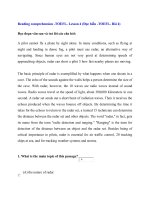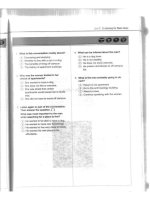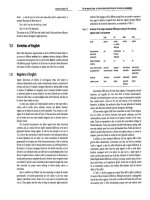Awa practise 4 pot
Bạn đang xem bản rút gọn của tài liệu. Xem và tải ngay bản đầy đủ của tài liệu tại đây (59.44 KB, 6 trang )
Of course, this line of reasoning is based on another problematic assumption, which is that the children
themselves are comparable in terms of their reading readiness, their interest in learning to read, and their gen-
eral ability to learn new concepts. For example, perhaps Jimmy had been able to recognize the letters of the
alphabet months before he started the phonics program, while Junior is still just learning to recite his ABCs.
In this case, Junior has a good deal of work to do before he can begin sounding out words with the phonics
program.
Likewise, Junior must be interested in learning how to read. If he is not, and his parents push him too
hard, he is likely to withdraw from the process, and his parents will find themselves frustrated trying to meet
a goal (Junior reading by age four) with a child who is not interested in meeting that goal. If Jimmy’s inter-
est in learning to read was strong, that could have had a significant impact on how much and how quickly
he learned with the phonics program.
Finally, another important factor is the children’s ability to learn. Even if both children started at the
same age, with the same basic reading readiness skills and the same level of interest, they may not have the
same ability to learn new concepts. Junior might struggle in areas in which Jimmy accelerated, and vice versa.
In short, the father’s argument rests on the assumption that the learning situations for Jimmy and Junior
are entirely comparable. But because there are so many variables to consider, such as reading readiness, other
reading preparation activities, and each child’s ability to learn, Junior’s father cannot logically assume Junior
will have the same success as Jimmy simply by purchasing a phonics program.
– AWA PRACTICE–
303IV
PART
The GMAT
Quantitative
SectionThe entire GMAT® quantitative part of the exam takes place in one section of the test. This section contains
37 questions and must be completed in 75 minutes. Therefore, the test taker can spend about two minutes
per question, on average. The questions in this section consist of two different multiple-choice formats: prob-
lem solving and data sufficiency. Each type of question has five possible choices for answers. These questions
test a person’s knowledge of mathematical concepts and their applications, along with thinking and reason-
ing skills. Examinees will be asked to recall the mathematics that they learned in middle school and high
school and apply these skills in an advanced manner for the questions on the test. Although scrap paper is
allowed, the use of calculators is prohibited on the GMAT exam.
Since the Quantitative section is only administered as a CAT, this section will be taken on a computer.
As each person takes the exam, the computer randomly generates the sequence of questions administered
based on the participant’s ability. The test begins with a question of average difficulty. If the question is
answered correctly, points are added to the score and a more difficult question follows. If the question is
answered incorrectly, there is no penalty, but an easier question follows. Keep in mind that harder questions
carry more weight and will result in a higher score. Because of the CAT format, each question must be
answered and confirmed before proceeding to the next question. Since randomly guessing an incorrect answer
CHAPTER
Quantitative
Pretest
18
307
will lower your score, making an educated guess by eliminating one or more of the answer choices should
result in a better score. Your score is based on both the number of questions you answer and the level of dif-
ficulty of the questions; the more difficult questions you answer, the better.
Even though the Quantitative section is administered on a computer, minimal computing skills are nec-
essary. Free GMAT tutorials can be downloaded from various Internet sites and taken ahead of time. The test-
ing site also offers a tutorial that can be completed immediately before commencing the test. These skills, such
as using the mouse and the HELP feature, should be practiced before beginning the test. Once you start a par-
ticular section of the exam, the clock cannot be stopped. Time spent asking for help will be counted in the
total time for that particular section.
The quantitative portion will not test how well you recall a lot of facts and figures; instead, it will test
how well you use your existing knowledge of math and how well you apply it to various situations. In addi-
tion, this section of the test will not evaluate your personality, work ethic, or ability to work with others.
Although the problems may seem difficult at times, they will not be assessing the undergraduate work you
may have completed in college or any particular course you may have taken; the math will be high school level.
Even though the test is used as a precursor for business school, the questions will not require knowledge of
business-related skills.
This section of the test contains a number of trial questions that are being field-tested for future use.
These particular questions will not be counted toward your total score; however, the actual questions are not
distinguished from the trial questions. Do your best on all of the questions and treat them as if they all count.
Problem Solving Questions
– QUANTITATIVE PRETEST–
308
1.abcde
2.abcde
3.abcde
4.abcde
5.abcde
6.abcde
7.abcde
8.abcde
9.abcde
10. a b c d e
11. a b c d e
12. a b c d e
13. a b c d e
14. a b c d e
15. a b c d e
16. a b c d e
17. a b c d e
18. a b c d e
19. a b c d e
20. a b c d e
ANSWER SHEET
Directions: Solve the problem and choose the letter indicating the best answer choice. The numbers used in
this section are real numbers. The figures used are drawn to scale and lie in a plane unless otherwise noted.
1. If both the length and the width of a rectangle are tripled, then the area of the rectangle is
a. two times larger.
b. three times larger.
c. five times larger.
d. six times larger.
e. nine times larger.









